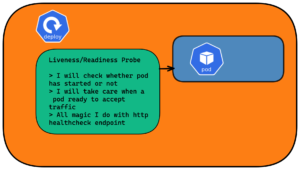
Liveness and Readiness probes are required in Kubernetes deployment to prevent deadlock of your application deployed and zero missing request while pod is initializing. When probe is configured in kubernetes deployment, each pod will go through probe conditions.
Liveness and readiness probes will be applicable to new pod which is created by horizontal pod autoscaling (hpa)
We are going to learn how to configure probes in kubernetes deployment:
Liveness probe: It will take care of the container when it is in deadlock or application not running by restarting container
Readiness probe: It will take care of the pod when to join the service to serve traffic
Prerequisites:
1) kubectl cli should be installed in your local
2) Connect to the kubernetes cluster
3) /health API should be enabled in application
4) Configmaps related to deployment should be deployed before deployment
Step 1:
Configure the liveness and readiness probe in the deployment yaml
Liveness probe:
livenessProbe:
httpGet:
path: /health
port: 8080
initialDelaySeconds: 60
periodSeconds: 3
Note: Liveness probe should be configured under template.spec.containers section under deployment yaml
Readiness probe:
readinessProbe:
httpGet:
path: /health
port: 8080
initialDelaySeconds: 60
periodSeconds: 3
Readiness probe configuration is similar to liveness probe and should be configured under template.spec.containers section under deployment yaml
Sample Deployment Yaml with probes:
apiVersion: apps/v1
kind: Deployment
metadata:
name: Myapp-deployment
labels:
apptype: java
spec:
replicas: 3
selector:
matchLabels:
apptype: java
tier: web
template:
metadata:
labels:
apptype: java
tier: web
spec:
containers:
- name: [container name]
image: [image from any container registry]
command: ["/bin/sh"]
args: ["java -Xmx2g -Xss256k -XX:MaxMetaspaceSize=256m -XX:+UseG1GC -XX:+HeapDumpOnOutOfMemoryError -XX:HeapDumpPath=/var/log/my-heap-dump.hprof -XX:+PrintGCDetails -XX:+PrintGCDateStamps -Xloggc:/var/log/myAppgc.log -jar [application.jar] --spring.config.location=[absolute path of the config maps mounted] "]
ports:
- containerPort: 8080
volumeMounts:
- name: appconfig
mountPath: "/config/application"
readOnly: true
livenessProbe:
httpGet:
path: /health
port: 8080
initialDelaySeconds: 60
periodSeconds: 3
readinessProbe:
httpGet:
path: /health
port: 8080
initialDelaySeconds: 60
periodSeconds: 3
volumes:
- name: appconfig
configMap:
name: [configmap-name]
Note: InitialDelaySeconds need to be higher value than application start up time
Here are the few fields we need to consider while configuring probes:
- initialDelaySeconds: Number of seconds after probe will start
- periodSeconds: gap between probe start
- timeoutSeconds: probe time out
- successThreshold: number of success probes after failure
- failureThreshold: Waiting time to perform restart container(Liveness Probe) and marking container unready(Readiness Probe)
- scheme: HTTP or HTTPS Defaults to HTTP.
- path: Path to access on the endpoint
- port: port to access on the container
Step 2:
Save the above mentioned deployment yaml and deploy it in kubernetes cluster by executing the below command
kubectl apply -f [deployment.yaml]
Conclusion:
Liveness and readiness probes will be very useful for the applications to route the traffic to stable/available pods which are passed with the health checks performed in probes.